In today’s data-driven world, businesses are constantly seeking ways to leverage information for strategic decision-making. Geographic Information Systems (GIS) have emerged as a powerful tool in the realm of business intelligence (BI), providing spatial context to data and enabling companies to gain deeper insights into their operations and markets. GIS mapping services offer specialized solutions that enhance the visualization and analysis of spatial data, making it easier for businesses to identify patterns, trends, and relationships. This blog explores the myriad benefits of integrating GIS with business intelligence, including the use of advanced GIS mapping services, and how it can transform various aspects of business operations
Understanding GIS and Business Intelligence
Before delving into the benefits, it’s essential to understand what GIS and business intelligence entail. GIS is a system designed to capture, store, manipulate, analyze, manage, and present spatial or geographic data. It allows users to visualize, question, and interpret data to understand relationships, patterns, and trends.
Business intelligence, on the other hand, refers to technologies, processes, and practices used to collect, integrate, analyze, and present business data. The goal of BI is to support better business decision-making. When GIS is integrated with BI, it enhances the ability to analyze data through a geographical lens, providing a new dimension to business insights. GIS services, including spatial analysis, geocoding, and interactive mapping, further enrich the BI process by offering detailed location-based data and visualization tools, enabling businesses to make more informed and strategic decisions.
Key Benefits of GIS for Business Intelligence
- Enhanced Data Visualization
One of the primary benefits of GIS in business intelligence is its ability to visualize data geographically. Traditional BI tools often present data in tabular or graphical formats. While these methods are effective, they may not always reveal spatial patterns or relationships. GIS allows businesses to create maps and spatial models that highlight geographical trends and correlations. For example, a retail company can use GIS to visualize sales data across different regions, identifying high-performing and underperforming areas at a glance.
- Improved Decision Making
GIS enhances decision-making by providing a spatial context to data. Businesses can analyze location-based data to make informed decisions about site selection, market expansion, logistics, and more. For instance, a company looking to open a new store can use GIS to evaluate potential locations based on factors such as population density, competitor locations, and accessibility. This spatial analysis helps ensure that decisions are data-driven and strategically sound.
- Optimized Resource Allocation
Efficient resource allocation is critical for business success. GIS helps businesses optimize the allocation of resources such as personnel, equipment, and inventory by providing insights into spatial distribution and demand patterns. For example, a delivery company can use GIS to plan efficient delivery routes, reducing fuel costs and improving delivery times. Similarly, utility companies can use GIS to manage and maintain their infrastructure, ensuring that resources are deployed where they are needed most.
- Enhanced Market Analysis
Understanding market dynamics is essential for business growth. GIS enables businesses to perform detailed market analysis by integrating demographic, socioeconomic, and behavioral data with geographic information. This comprehensive analysis helps businesses identify target markets, understand customer preferences, and tailor their marketing strategies accordingly. For example, a real estate company can use GIS to analyze property values, demographic trends, and local amenities to identify lucrative investment opportunities.
- Improved Customer Relationship Management (CRM)
GIS can significantly enhance customer relationship management by providing a spatial dimension to customer data. Businesses can analyze customer locations, purchase patterns, and preferences to develop targeted marketing campaigns and personalized services. For instance, a telecommunications company can use GIS to identify areas with high customer churn rates and develop strategies to retain customers in those regions. Additionally, GIS can help businesses optimize their service areas and improve customer satisfaction by ensuring timely and efficient service delivery.
- Risk Management and Mitigation
GIS plays a crucial role in risk management and mitigation by providing insights into potential risks and vulnerabilities. Businesses can use GIS to analyze natural hazards, environmental factors, and socio-political conditions that may impact their operations. For example, a manufacturing company can use GIS to assess the risk of natural disasters, such as floods or earthquakes, and develop contingency plans to ensure business continuity. Similarly, financial institutions can use GIS to evaluate the risk of lending in different regions and make informed decisions about credit allocation.
- Supply Chain Optimization
Efficient supply chain management is vital for business success. GIS helps businesses optimize their supply chains by providing insights into transportation networks, distribution centers, and demand patterns. By analyzing spatial data, businesses can identify bottlenecks, reduce transportation costs, and improve overall supply chain efficiency. For instance, a retail company can use GIS to determine the optimal locations for warehouses and distribution centers, ensuring that products reach customers quickly and cost-effectively.
- Environmental and Sustainability Planning
As businesses increasingly prioritize sustainability, GIS has become an essential tool for environmental planning and management. GIS enables businesses to assess the environmental impact of their operations, monitor resource usage, and develop sustainable practices. For example, a construction company can use GIS to analyze the environmental impact of a new project and implement measures to mitigate adverse effects. Similarly, agricultural businesses can use GIS to monitor soil health, optimize water usage, and promote sustainable farming practices.
- Enhanced Competitive Advantage
Integrating GIS with business intelligence provides a competitive advantage by offering unique insights that competitors may not have. Businesses can leverage GIS to identify emerging trends, anticipate market shifts, and stay ahead of the competition. For example, a retail company can use GIS to analyze competitor locations and identify underserved markets, allowing them to expand strategically. By harnessing the power of GIS, businesses can make proactive decisions and seize opportunities that others may overlook.
Read more: Application of GIS in Natural Resource Management
Real-World Examples of GIS in Business Intelligence
Several companies across various industries have successfully integrated GIS with business intelligence to drive growth and efficiency. Here are a few examples:
- Retail: Walmart uses GIS to optimize store locations, manage supply chains, and analyze customer demographics. By leveraging GIS, Walmart can ensure that stores are strategically placed to maximize sales and customer satisfaction.
- Healthcare: Hospitals and healthcare providers use GIS to map disease outbreaks, analyze patient demographics, and optimize the allocation of medical resources. During the COVID-19 pandemic, GIS played a crucial role in tracking the spread of the virus and planning vaccination campaigns.
- Logistics: FedEx and UPS use GIS to plan delivery routes, manage fleet operations, and optimize logistics networks. GIS helps these companies reduce transportation costs, improve delivery times, and enhance overall operational efficiency.
- Real Estate: Real estate companies use GIS to analyze property values, assess market trends, and identify investment opportunities. GIS enables these companies to make data-driven decisions about property development and sales.
Conclusion
The integration of GIS with business intelligence offers numerous benefits hat can transform various aspects of business operations. From enhanced data visualization and improved decision-making to optimized resource allocation and competitive advantage, GIS provides a spatial dimension that enriches traditional BI insights. As technology continues to evolve, the use of GIS in business intelligence will become increasingly sophisticated, enabling businesses to harness the full potential of their data and drive strategic growth. By embracing GIS, businesses can stay ahead of the curve, make informed decisions, and achieve sustainable success in today’s dynamic market.
At MicroGenesis, our GIS consulting services can help your organization leverage these benefits. Our experts provide tailored solutions that integrate GIS with your existing business intelligence systems, ensuring you maximize the value of your data and gain a competitive edge.




